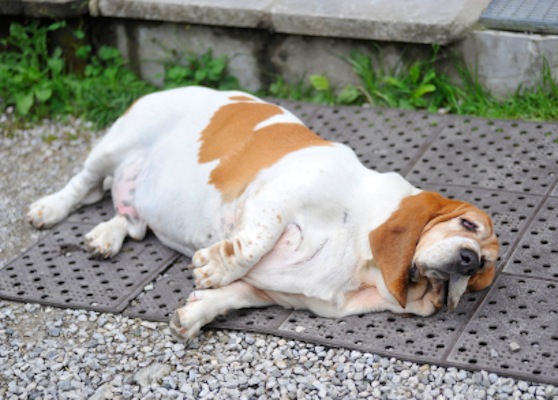Dog Obesity: Causes and How to Help your Dog Lose Weight
Sadly, the percentage of overweight pets in the United States keeps growing. According to the 2014 National Pet Obesity Awareness Day Survey, an estimated 52.7 percent of dogs in the United States were overweight or obese. By 2018, that number increased to 55.8%, that is a 5.9% jump1.
The Association for Pet Obesity Prevention had to delay their survey last year, however according to an article published in April, 2021 by Chronicle Live, a survey conducted by an independent pet food manufacturer revealed that 44% of owners have fed their dog more treats every week during the pandemic and veterinarians have seen an increase in obesity cases2.

As the nation has acknowledged the overweight problem of its human citizens, our dogs’ weight has been increasing alongside us. Obesity is a serious problem in dogs and should not be considered as a sign of cuteness.
How is dog obesity determined?
Most veterinarians use a body condition scoring system to determine the level of appropriate weight for a pet. Mostly the score is determined by feeling the dog’s ribcage and examining a dog’s waistline and stomach. The system checks off scores between 1-9 with 1 being emaciation and 9 being morbidly obese3.
All pets should have a clearly defined natural waistline or tuck that occurs immediately behind the ribcage. There shouldn’t be any hanging waistline either. Instead, the belly-side of a dog should lie against the body.
Feeling the dog’s ribcage is one of the best indicators of condition. If you can’t feel a dog’s ribs at all, he is most definitely overweight! Ribs can be covered in fat, so ribs that can’t be detected are wrapped in layers of fat. A dog’s ribs should be able to be felt, but not excessively.
Obesity: How does it happen?
While there are instances of weight gain due to medical conditions or as a side effect of various medications, the most common culprits are excess food and lack of exercise.
These are the same reasons highlighted for human obesity; the main difference is that the dog has little control over his level of exercise and food intake. Our society has changed, and while more dogs living in the house have been a good thing for longevity, many of these same dogs are not trained or exercised on a daily basis.
Too much food is the other culprit. Speak with your veterinarian about what your dog should weigh and how much food would be reasonable. Use the “Feeding Recommendation” on the side of the dog food bag as only a starting point. Active dogs will always require more food than inactive ones, so food intake must be monitored. Also, food should always be measured. Don’t free feed your dog or have an endless bowl policy.
Remember that treats, goodies, and supplements can all count as dietary intake and add calories and fat to your dog’s diet. All of the chewing bones and similar products, all count as food intake, so you must adjust the diet accordingly.
Obesity: What are the problems and how to fix it?
A few extra pounds on a pudgy dog might not seem like a lot or might even seem cute in some, but unfortunately, the costs to the dog add up. There are a whole myriad of issues that can arise, many of them similar to what humans experience. The difference is: 15 extra pounds on a dog is not similar to 15 pounds on a person. The effects are greatly enhanced in dogs.
Overweight dogs can experience a range of issues such as lethargy, exercise intolerance, exhaustion, difficulty breathing, stiff and sore joints, difficulty walking or navigating obstacles, reduced interest in play, heart problems, diabetes, and various other serious medical conditions.
While it took more than a day for the dog to become fat, it will take time for him to lose the weight. A weight loss plan must be undertaken carefully. Develop a plan with a trusted veterinarian and conduct a physical prior to make sure the dog doesn’t already have a potentially complicating medical condition.
How to Help Your Dog Lose Weight
1. Reduce your dog’s daily food intake only a small amount at first. For example, if you feed 1 cup of food a day, reduce by just ¼ cup.
2. Add in other items that are filling but low calorie. Vegetables make a great chew item that is both nutritious and low calorie. Try carrots, green beans, or sweet potatoes.
3. No table scraps! Try to keep a journal of what your dog is eating each and every day to make sure no extras are making their way into the diet.
4. Use alternatives. If working on obedience training and needing to use treats, try low calorie choices like veggies, Cheerios or use the dog’s daily food ration along with a few pieces of freeze-dried liver.
5. Slowly introduce exercise. If your pet is morbidly obese, you might have to reduce some weight through food first and then add in exercise. If exercise is difficult, try contacting a pet physical therapist about water based therapy. An underwater treadmill provides great exercise but is much easier on the dog’s body.
Citations:
1. The Association for Pet Obesity Prevention- APOP
2. “Over a third of dog owners admit their pampered pets are overweight.” Chronicle Live 5 April 2021.
3. Thorndyke, Jordan. “Pet obesity a growing problem.” Herald-Sun (Durham, NC) 29 Sept. 2009. General OneFile. Web. 21 Dec. 2009.
